Sightseeing
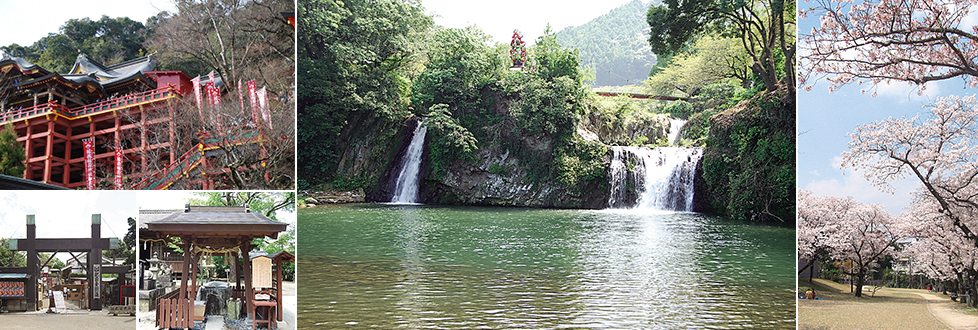
Shida-yaki Pottery Factory Museum
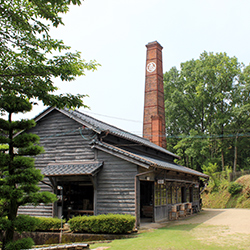
Following Arita, the town where porcelain was fired successfully in Japan for the first time, Shiota town of Ureshino city began making porcelain in the 1700s, in the Nishiyama and Higashiyama kilns, using Amakusa porcelain stone. In contrast to the premium porcelain produced in Arita, Shiota developed as a pottery town which produced Shida-yaki pieces in large volumes for the general populous.
Amongst a variety of products, the big plates depicting Shan shui landscapes or animals with long, easy brush strokes, are certainly the finest that Shida-yaki has to offer.
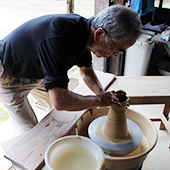 Shida-yaki reached the height of its popularity after entering the 19th century. Pottery was produced to suit the needs of the various ages, namely the end of the Edo Period, Meiji and Taisho. The Shidayaki-no-Sato Museum was once an actual factory which produced Shida-yaki products until it was closed in 1984 and was converted into the museum it is today.
It is a valuable facility where one can be introduced to all of the processes involved in porcelain manufacturing during the Taisho and early Showa Periods, from creating potter's clay to shaping, decorating and firing.
Shida-yaki reached the height of its popularity after entering the 19th century. Pottery was produced to suit the needs of the various ages, namely the end of the Edo Period, Meiji and Taisho. The Shidayaki-no-Sato Museum was once an actual factory which produced Shida-yaki products until it was closed in 1984 and was converted into the museum it is today.
It is a valuable facility where one can be introduced to all of the processes involved in porcelain manufacturing during the Taisho and early Showa Periods, from creating potter's clay to shaping, decorating and firing.
Further info..
Hizen Yoshida-Yaki Pottery Hall
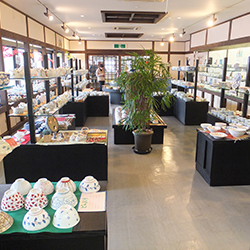
Although the year when Yoshida-yaki was established is not clear, unraveling the history of ceramics and porcelain in Ureshino, it seems that Takanobu Ryuzoji discovered a stone which glowed white in the bottom of Narutani River, upstream of Haguchi River which runs through Yoshida village, when he lead a campaign on Harunobu Arima of Omura in 1577. This is said to mark the beginning of Japan's porcelain mining.
Nabeshima Naozumi was Saga Domain's lord from 1624 to 1644, and upon his retirement, he worked to encourage the ceramics and porcelain businesses of Mt. Yoshida.
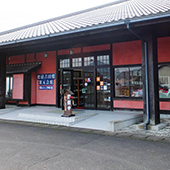 Between 1801 and 1804, Iemon Fukushima increased the number of kilns beyond the limit, expanding the business and helping Yoshida-yaki to thrive.
However, the business began to gradually decline after the Meiji Restoration so Seiseisha was established in 1880 and improvements were made. After this, efforts were exerted to manufacture daily-use crockery for exports to China and Korea, however this became more and more tailored towards Japanese domestic use, to become what it is today.
Taking pride in history and tradition, the kilns of Hizen Yoshida-yaki still strive to improve their technologies today.
Between 1801 and 1804, Iemon Fukushima increased the number of kilns beyond the limit, expanding the business and helping Yoshida-yaki to thrive.
However, the business began to gradually decline after the Meiji Restoration so Seiseisha was established in 1880 and improvements were made. After this, efforts were exerted to manufacture daily-use crockery for exports to China and Korea, however this became more and more tailored towards Japanese domestic use, to become what it is today.
Taking pride in history and tradition, the kilns of Hizen Yoshida-yaki still strive to improve their technologies today.
Yutoku Inari Shrine
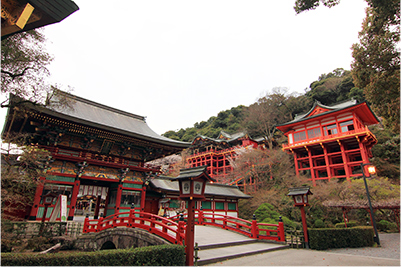
Along with the Fushimi Inari Shrine and Kasama Inari Shrine, the Yutoku Inari Shrine is known as one of Japan's three major Inari and fondly referred to as "Yutoku san" by the locals. Built in 1687, the Yutoku Inari Shrine was given a division of a shrine's tutelary deity from the Inari Okami that sat neatly on the Kazan-in estate located in the Kyoto Imperial Palace when Kashima's Lord Naotomo Nabeshima married his wife, Princess Kazan-in Manko from Kyoto.
The contrast of the vivid vermillion color of the buildings and the surrounding greenery is truly impressive, while the main architecture, including the main shrine, front shrine and the two-storied gate, is completely coated in lacquer. The main shrine stands tall with a backdrop of a stone wall mountain and there is a two-storied romon gate and Kagura Hall situated on the spacious shrine grounds at the skirt of the mountain.
The Yutoku Inari Shrine is also fondly called "Chinzei Nikko", meaning Nikko of the Kyushu region. Worshipped as the ancestral god of food, clothing and shelter, as well as the guardian god of rich harvests, good business, family prosperity, large fish hauls and traffic safety, the shrine is visited by more than 2.8 million every year. The shrine holds rituals including a spring festival named Tamagae on April 8 and an autumn festival named Ohitaki on December 8.
In addition, the outer garden of the Yutoku Inari Shrine is part of Higashiyama Park, a famous spot for viewing azalea flowers. The park is filled with nearly 50,000 stocks of blooming azalea flowers during the season.
Further info..
Mifuneyama Rakuen (Mifuneyama Rakuen Park)
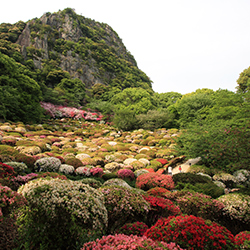
Mifuneyama Rakuen Park is home to some of Ureshino’s most inspiring and beautiful Japanese gardens.
The gardens attract visitors all year round, with each season offering it’s own charming and exquisite landscape, from the full bloom of the Cherry Blossoms in spring to the vibrant colours of the Wisteria and Azalea trees in autumn. Witnessing the truly magnificent red and yellow leaves of the maple trees at dusk is not to be missed.
Getting there is easy; it’s just a 20-minute drive, or bus ride from the Ureshino onsen bus terminal.
Further info..
Karatsu Castle
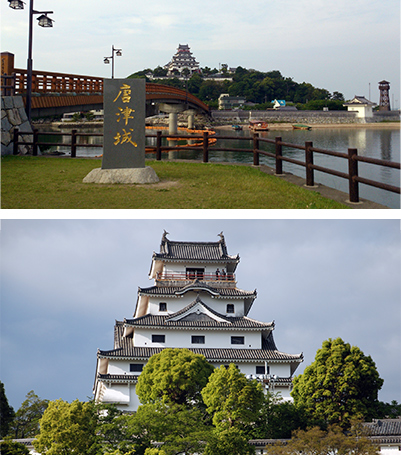
Karatsu Castle, a symbol of the city, was constructed in 1608 after seven years of construction beginning in 1602 by the first lord of the Karatsu Domain, Hirotaka Terasawashimanokami. Karatsu Castle was built on an island called Mount Mitsushima, connected to the mainland by land and the castle keep was in Mount Mitsushima.
Inside the castle were walls built of stone and a moat.
After the abolition of feudal domains and the establishment of prefectures in 1871, the castle was abandoned and the remains of the main enclosure of the castle was transformed into Maizuru Park.
The present building was restored in 1966 as a cultural and tourist facility. The 5-story castle tower towers over the sky of Karatsu.
The castle is also called Maizuru Castle since the castle tower is likened to a head of a crane and the pine forests growing to the left and right of the castle resemble a crane spreading its wings.
The castle houses invaluable materials and weapons that bear evidence of centralized feudalism, materials related to the Karatsu-yaki wares, as well as archaeological and historical resources.
The fifth floor of the castle tower is an observatory offering a commanding view of the Sea of Genkai and the Matsuragata region. To get to the castle tower of the Karatsu Castle, visitors can walk up stone steps or take an elevator.
The Maizuru Park located on the periphery of the castle is a famous spot to view cherry blossoms and wisteria flowers when they are in full bloom. The Karatsu Castle is illuminated at night, making for a gorgeous sight to behold.
Further info..
Arita
A visit to Kyushu would not be complete without visiting the beautiful town of Arita, the home of Japan’s magnificent ceramic industry.
Arita offers an abundance of shops and studios, showcasing some of the best ceramic art Japan has to offer. With so many ceramics on offer, you’ll be sure to find the perfect gift or souvenir to take home. Plus, discover the fascinating history of Japanese ceramics at the Kyushu ceramic museum, displaying some of the most beautiful examples of ceramics from Kyushu.
Further info..
The Saga Prefectural Kyushu Ceramic Museum
The Kyushu Ceramic Museum collects potteries and porcelains from all over Kyushu mainly the Hizen Porcelains. Inside the museum, the history of Kyushu ceramics and the characteristics of each era are exhibited in detail, as well as the artworks of contemporary potters.
There are five exhibition rooms; the first offers a variety of special exhibitions throughout the year; the second exhibition room offers a permanent exhibition titled Contemporary Kyushu's Pottery Art, exhibiting an extensive collection of artworks from tea bowls made by contemporary pottery artist representative of each prefecture in the Kyushu region to avant-garde pottery pieces.
The third exhibition room consists of a permanent exhibition of Kyushu's ceramics, showing ceramic masterpieces such as the Hizen Kokaratsu ware, early Imari-yaki pottery, Kakiemon style ceramics and the ceramics of the Nabeshima Domain Kiln.
The fourth exhibition room features the history of Kyushu ceramics and regional characteristics in detail, as well as the section dedicated for a collection of Kanbara ceramics. The exhibition is a sight to see as it houses an extensive collection of the Koimari-yaki adorned with fascinating gorgeous decoration, which were exported to Europe from the Imari Port, attracting royalty and the aristocracy of the times. What is more, it houses nearly 1,000 Arita-yaki pieces from the Edo Period, named Mr. and Mrs. Shibata's collection, in the fifth exhibition room as a permanent exhibition.
In the Exhibition hall, there is an Arita-yaki wind-up musical clock, which sounds every thirty minutes. Spending a day at the Kyushu Ceramic Museum makes you an expert on Kyushu ceramics. The twenty-five porcelain wind chimes on the exterior walls of the museum, which were given from Meissen, Germany; a sister city of Arita town, sound every hour, pealing out their beautiful and clear sound all around the museum.
Further info..
Arita Porcelain Park and Nonnoko no Sato
Arita Porcelain Park is a park which could only have been created in the home of Arita-yaki, a pottery style which influenced ceramics and porcelain around the world and fascinated European royalty and aristocracy from the 17th century onwards. The first amazing scene to leap into view is the symbol of Porcelain Park, a superb reproduction of the Zinger Palace in Germany, built at the beginning of the 18th century and said to be the epitome of Baroque Architecture. The Zinger Palace of Arita Porcelain Park houses works from the second period of exportation which lasted from the end of the Tokugawa shogunate reign to the Meiji Period. Moreover, visitors to the park can also experience Arita-yaki pottery first-hand or take a tour of the sake brewery to see how sake, shochu and beer, purchase alcohol, or taste sake only available directly at the brewery itself. The park also offers an abundance of dining choices including Western and Japanese cuisines or buffet-style dining, as well as a cafe and bakery. Arita Porcelain Park is a place where visitors can spend the whole day relaxing and leisurely viewing the flowers.
Sakagura-dori (sake brewery street).
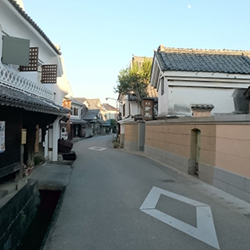
Sakagura-dori is where you can find many Japanese sake breweries, and is just a 30 minute drive from Ureshino.
The brewery, which produced the much-applauded 2011 International Wine Challenge Champion Sake Winner "Nabeshima" can be found on this street.
Each spring & autumn, sake lovers from all over Japan gather to Sakagura-dori to enjoy the wonderful and ever popular "Sakagura-dori sake festival".
Saga Prefectural Space and Science Museum

Based on the theme of "Observing Earth and Saga from outer space, and observing Earth and outer space from Saga" , Saga Prefecture Space & Science Museum is a place where people can have fun with science through participation and experience.
The eye-catching exterior of building was designed to resemble a spaceship awaiting takeoff from a space station.
The exhibits are so elaborated that visitors can learn the Universe, the Earth and Saga each and their relationship as well. Also a variety of science classes and shows are being held. On the third floor, a planetarium equipped with a state-of-the-art projector, with the capacity of 200 seats is able to reproduce the night sky of countless glittering stars in three-dimensional outer space. From the observatory one can watch spectacular sun, planets and stars. Offering many hands-on experience programs which are enjoyable like playing games, the museum cultivates curiosity towards science of visitors of all ages, from children to adults, and enables them to encounter the wonderfulness of discovery and creation.
Further info..
Nagasaki
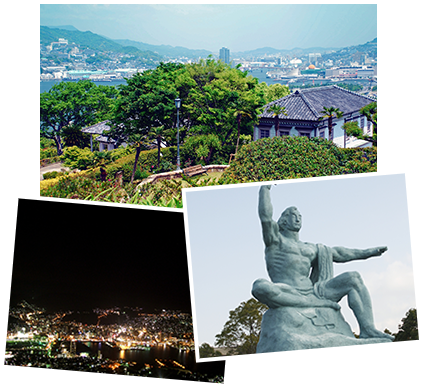
Nagasaki offers two very different perspectives to its many visitors. On one side you will experience the beautiful scenery with its rich and multicultural background, and a bustling array of influences from Chinese, Western and Japanese cultures.
Here, you will find a unique dining experience just waiting to be discovered. Famous local dishes include ‘Champon’, a delicious dish of noodles, seafood and vegetables, and ‘Toruko Rice’ which is a western inspired dish, where Pilaf rice and spaghetti are piled high onto plates and served with pork cutlets and generous amounts of a tomato based sauce.
In contrast, Nagasaki’s other side shows the devastation and suffering caused by the impact of the atomic bomb on August 9th 1945 during World War II. A visit to both the Nagasaki Peace Park and the Nagasaki Atomic Bomb Museum are highly recommended. Not only do they commemorate this tragic period, but they also symbolize the hope for eternal peace.
Further info..
Huis Ten Bosch
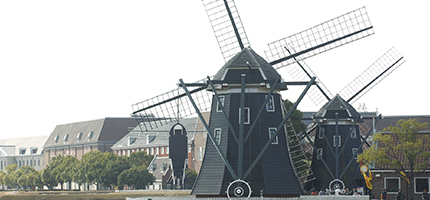
Huis Ten Bosch is Japan’s biggest theme park, and only a 50-minute drive from Ureshino.
At over 1.5 million square metres, Huis Ten Bosch literally translates into English as ‘House in the Forest’ and recreates the Netherlands with full size replicas of Dutch buildings, streets, boats & windmills.
The park also features an amazing funfair, hotels, villas, museums and shops.
There are a huge selection of restaurants, café’s and bars offering a fantastic array of Asian and European cuisine.
Getting around this huge park is best achieved with a combination of walking, cycling and canal cruising.
Special events are held all year round including the incredible Hydrangea flower festival and market. The park is also famous for its amazing night-time views and entertainment.
Further info..
Kujukushima Pearl Sea Resort
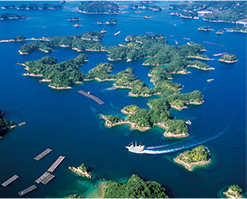
Kujukushima Pearl Sea Resort is a sea themed resort just an hour’s drive from Ureshino.
The resort has a fantastic aquarium offering frequent exhibitions, and is worth a visit alone for it’s beautiful collection of jellyfish.
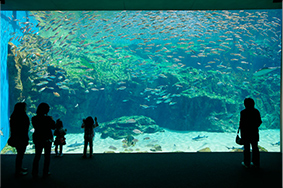 Taking a cruise tour around the beautiful Saikai National Park is highly recommended, with it’s array of picturesque small islands and unique coastline.
There are a variety of ships and boats you can board to explore the uninhabited islands, from large classic wooden vessels to sea kayaks and sailing yachts.
Kujukushima Pearl Sea Resort offers a wide variety of exciting events throughout the year.
Before planning your visit, please check out their web site for all you need to know.
Taking a cruise tour around the beautiful Saikai National Park is highly recommended, with it’s array of picturesque small islands and unique coastline.
There are a variety of ships and boats you can board to explore the uninhabited islands, from large classic wooden vessels to sea kayaks and sailing yachts.
Kujukushima Pearl Sea Resort offers a wide variety of exciting events throughout the year.
Before planning your visit, please check out their web site for all you need to know.
Further info..

